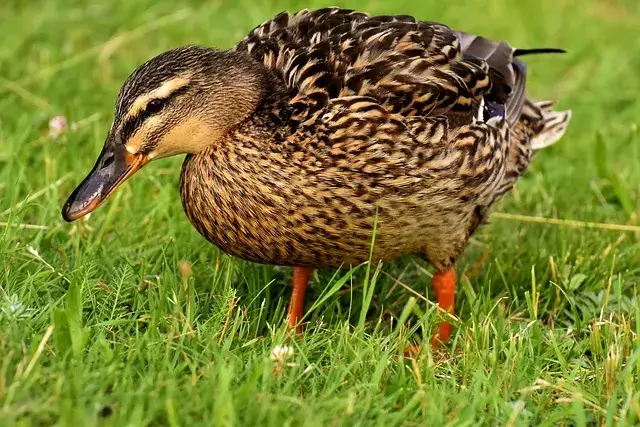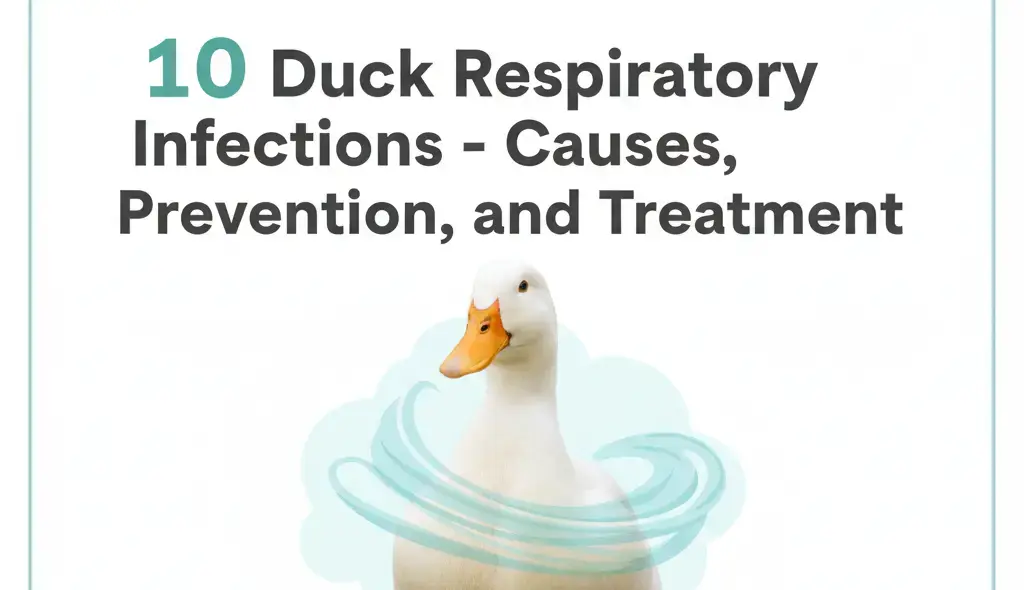That sound is terrifying.
The gasp. The wheeze. The wet cough from the corner of the brooder.
You look over and see a duck, neck outstretched, tail bobbing, struggling for air.
It’s a feeling I know all too well. Your stomach drops.
Is it just dust? Is it a deadly disease? Will it spread to the whole flock?
I’ve been in that exact spot, and the panic is real.
But after 30 years of raising waterfowl, I’ve learned that panic doesn’t help.
A plan does.
Most duck respiratory infections fall into one of ten categories.
I’m going to walk you through all of them.
No fluff. No complex vet-speak.
Just the simple, actionable guide I wish I’d had.
Let’s get your ducks breathing easy again.
The First Signs: How to Spot a Duck Respiratory Infection
Before we break down the “who’s who” of duck illnesses, you need to know the red flags.
A sick duck will try to hide it. You have to look closer.
If you see any of these signs, your first move is always to isolate that duck.
Symptoms of a sick duck:
- Nasal discharge: Any liquid (clear, foamy, or thick) from the nostrils.
- Ocular (eye) discharge: Bubbly, foamy, or watery eyes.
- Sneezing or coughing: This is an obvious one. It can sound like a “huff” or a wet cough.
- Wheezing or gurgling: A clicking, rattling, or whistling sound when they breathe.
- Gasping / Open-mouth breathing: They can’t get enough air through their nares.
- Tail bobbing: Their tail moves up and down with every strained breath.
- Swollen face or sinuses: Their head looks puffy, especially around the eyes.
- Lethargy: Sitting hunched, not moving, not interested in food or water.
- Change in “quack”: Their voice sounds hoarse, weak, or different.
If you see this, isolation is your new best friend. Now, let’s figure out what you’re dealing with.

The “Big 10” Duck Respiratory Infections (And What to Do)
Here are the most common culprits, from the easily-fixed to the flock-enders.
1. Aspergillosis (The Moldy Menace)
This one is brutal, and it’s one of the most common respiratory infections I see in young ducklings.
Cause: A fungus, Aspergillus. It grows in damp, moldy bedding (especially straw or hay) and moldy feed. The duck inhales the spores.
Symptoms: Severe gasping, tail-bobbing, and weakness. It’s often called “brooder pneumonia.”
Treatment: Honestly? It’s almost always fatal. Antifungal drugs (like Itraconazole) from a vet might work if caught impossibly early, but the Merck Veterinary Manual states there is no effective treatment in poultry.
Prevention: This is 100% your focus.
- Keep your brooder bone dry.
- Use pine shavings, not straw or hay, which mold less.
- Clean waterers daily so they don’t soak the bedding.
- Never, ever use feed that smells musty or damp.
2. Avian Influenza (The “Bird Flu” Reality)
This is the one everyone fears. It’s viral, highly contagious, and deadly.
Cause: A virus (HPAI – Highly Pathogenic Avian Influenza). Ducks, especially wild ones, are natural carriers and can infect domestic flocks.
Symptoms: This is the scary part. Often, the first symptom is sudden death. You may also see extreme depression, swelling of the head and wattles, nasal discharge, and diarrhea.
Treatment: There is no treatment. It must be reported to state authorities immediately. As of October 2025, the USDA APHIS continues to monitor HPAI detections in wild birds, confirming it’s an ever-present threat.
Prevention: Biosecurity. Biosecurity. Biosecurity.
- Stop wild birds from accessing your ducks’ feed and water.
- Use dedicated “coop boots” that you don’t wear anywhere else.
- Quarantine any new birds for at least 30 days.

3. Riemerella anatipestifer (The “New Duck Disease”)
This is a bacterial infection that can look like a dozen other things.
Cause: Riemerella anatipestifer bacteria. It spreads through the air or tiny cuts on their feet.
Symptoms: It’s a mixed bag. You’ll see typical respiratory signs (coughing, sneezing, nasal discharge) but also weird nervous system signs. Think twisted neck, lameness, and a “penguin-like” stance.
Treatment: Needs a vet. This requires aggressive antibiotics, and even then, it can have a high failure rate in ducklings.
Prevention: Cleanliness. It’s hard to eliminate the bacteria, so you prevent it from taking hold by reducing stress and keeping the brooder and coop spotless.
4. Fowl Cholera (The Silent Killer)
This is another nasty bacterial infection, especially common in adult ducks.
Cause: Pasteurella multocida bacteria. It’s often spread by rodents, wild birds, or contaminated water.
Symptoms: In the acute form, ducks just die. You find them dead with no prior signs. In the chronic form, you’ll see labored breathing, mucoid discharge from the mouth, and diarrhea.
Treatment: Sulfa-based antibiotics from a vet can work to stop an outbreak, but it won’t cure carriers.
Prevention: Rodent control. This is non-negotiable. Also, ensure your ducks have clean, fresh water, not a stagnant pond they share with wild animals.
5. Mycoplasma (The “Walking Cold”)
If your duck sounds “snick-y” or has a persistent cough and bubbly eyes, this is my first guess.
Cause: A Mycoplasma organism (like M. gallisepticum). It’s highly contagious and spreads easily.
Symptoms: Puffy face, swollen sinuses, bubbly or foamy eyes, and a chronic “snick” or sneeze. It can also cause lameness (joint swelling).
Treatment: Antibiotics like Tylan (Tylosin) can manage the symptoms, but it’s very hard to fully cure. Many birds remain carriers for life.
Prevention: Quarantine new birds. This is the #1 way it enters a flock.
6. Duck Virus Enteritis (Duck Plague)
This viral disease is as bad as it sounds.
Cause: A herpesvirus specific to waterfowl.
Symptoms: Sudden death. You may see a loss of fear, extreme thirst, and a bloody discharge from the vent or nostrils. Internally, it causes massive hemorrhaging.
Treatment: None.
Prevention: A vaccine exists and is very effective. The Cornell University Duck Research Laboratory is the primary source for this. If you have a large or valuable flock, talk to your vet about vaccination.
Also read: Duck Egg-Bound
7. Gapeworm (The Parasite in the Throat)
This one gives me the creeps, but it’s very treatable.
Cause: A parasitic roundworm (Syngamus trachea) that attaches to the trachea (windpipe). Ducks pick it up by eating intermediate hosts like earthworms, slugs, or snails.
Symptoms: The classic “gape.” The duck will stretch its neck, gasp, and shake its head, trying to dislodge the worm.
Treatment: Easy. A wormer containing Flubendazole.
Prevention: Regular deworming and keeping ducks off wet, “slug-heavy” ground can help.
8. Air Sac Mites (The Tiny Clickers)
This is another parasitic nightmare that directly impacts breathing.
Cause: A tiny mite (Sternostoma tracheacolum) that lives in the duck’s trachea, lungs, and air sacs.
Symptoms: A distinctive “clicking” or wheezing sound, especially at night. You’ll see coughing, head-shaking, and a loss of voice.
Treatment: Needs a vet-prescribed anti-parasitic, often Ivermectin. Do NOT try to dose this yourself; it’s very easy to overdose a bird.
Prevention: Treat the flock if one bird has it. It’s highly contagious.
Also read: Duck Life Stages
9. Bacterial Pneumonia (The Opportunist)
This isn’t one specific disease, but a secondary infection.
Cause: Other bacteria (like E. coli or Staphylococcus) that take over when a duck’s immune system is already weak from stress, bad air, or another mild illness.
Symptoms: Classic pneumonia: gurgling, labored breathing, lethargy, fever.
Treatment: Needs a broad-spectrum antibiotic from your vet.
Prevention: Stop the stress. This means clean bedding, no overcrowding, and good food.
10. Ammonia Burn (The “Infection” That Isn’t)
I saved this for last because it’s the most common and the most preventable.
It’s not an infection. It’s a chemical burn.
Cause: High levels of ammonia gas building up from wet, soiled bedding. The gas is trapped in a poorly ventilated coop.
Symptoms: It perfectly mimics an infection. You’ll see crusty, swollen eyes (keratoconjunctivitis), coughing, and gasping as the fumes burn their respiratory tract.
Treatment: Get them into fresh air. Immediately. Clean the coop completely and add fresh, deep, dry bedding.
Prevention: Ventilation. You need good airflow (without a draft) to pull that heavy, toxic gas off the floor.

Your Best Defense is a Good Offense: Real Prevention
Worried about all this? Good.
Now, let’s channel that worry into action.
I can tell you that 90% of the duck respiratory infections I’ve seen could have been prevented.
Here’s the simple checklist.
- Dry Bedding is Non-Negotiable. Ducks are wet. Their bedding can’t be. Use deep pine shavings and change wet spots daily. A clean brooder is life. This is the first thing I cover when teaching people how to raise baby ducks.
- Ventilation. Ventilation. Ventilation. I can’t say this enough. Your coop needs airflow, especially vents near the roof to let warm, moist air out. Building a perfect duck coop means focusing on airflow more than warmth.
- Clean Water, Clean Feed. Waterers should be cleaned daily. Don’t let feed get wet or musty. Good nutrition builds a strong immune system, so be sure you know what ducks should be eating.
- Stop Rodents. They carry Fowl Cholera and other diseases. Set traps. Secure your feed in metal cans.
- Quarantine. All new birds. 30 days. No exceptions.
My Final Word on Duck Respiratory Infections
It’s scary. But you’re in control.
Listen to your birds. Watch them.
You’ll learn the difference between a happy “huff” and a sick “gasp.”
Don’t wait. Don’t “see how they look tomorrow.”
If you see the signs, isolate the bird immediately.
Clean the coop. Check the feed. Improve the ventilation.
And then, call a vet. Don’t guess with antibiotics.
A simple, dry, clean home is the best medicine you can ever give your flock.
Frequently Asked Questions (FAQs)
Why is my duck breathing with its mouth open?
This is almost always a sign of severe distress. The duck can't get enough oxygen. It could be heat stroke, but it's more likely a blockage (Gapeworm), a fungal infection (Aspergillosis), or a severe viral/bacterial infection. Isolate the duck in a cool, quiet place and call a vet.
Can I get sick from my duck's respiratory infection?
It is extremely rare, but yes. Avian Influenza (HPAI) is the main concern. This is why you should always practice good hygiene. Wash your hands after handling birds, especially sick ones. Don't touch your face. If you have a suspected HPAI case, you must report it.
What are those bubbles in my duck's eye?
That's called ocular discharge. It's a classic sign of a respiratory infection, especially Mycoplasma or an early bacterial infection. The tear ducts are connected to the sinuses, so when the sinuses swell, it pushes air and fluid out through the eye.
Can I just give my sick duck some antibiotics?
How do I know if it's an infection or just ammonia?
Get low. Put your head at duck-level in the coop and take a deep breath. If your eyes water or you want to recoil, that's an ammonia problem. The smell will be sharp and unmistakable. A healthy coop should smell earthy, not like a dirty litter box.


